Paul lives in the village of Ntonso in the Ashanti region of Ghana. It is well known for its textile industry and is visited by many tourists. The textile workers of Ntonso specialise in a traditional textile called adinkra, which is used in mourning ceremonies. It is a cloth which is dyed black, and then marked with a different dye using stamps and other tools. Paul carves the stamps which are used to apply the dye to the cloth.
The stamps which are used to apply the dye are also sold to tourists as artistic objects in their own right, being representations of traditional patterns, all of which have meaning.
Paul showed me the pattern which he intended to carve for me – called Fihankra, signifying safety or security in a home.
His raw material is calabash, the hard-wearing seedcase which is used in a hundred different ways throughout Ghana. Paul obtains his calabash from traders who have used it to transport shea butter to Ntonso from northern Ghana, where the shea tree grows. Shea butter is extracted from the tree’s fruits, and is used as a cosmetic and in cooking.
The first step is to cut the calabash fragment to the right size and then to mark guidelines for the pattern on the calabash shell.
Paul then uses a number of small knives to cut the pattern into the calabash shell, and constructs a handle from slivers of bamboo.
Paul said that he was good at art when he was in school, so that was a good reason for becoming an adinkra stamp carver. He earns his living by selling his stamps to the textile workers, but also to tourists, for whom he has a table displaying stamps he has carved – some of which have been used.
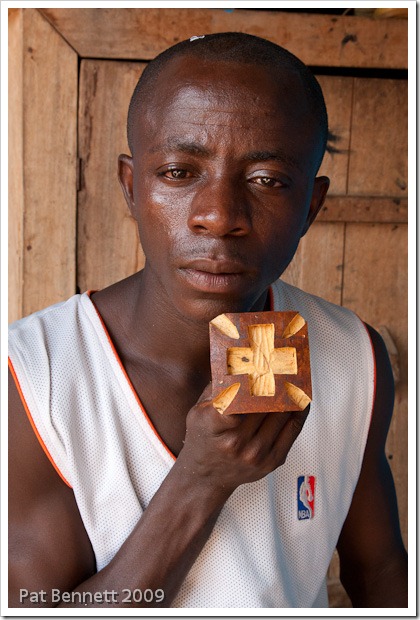
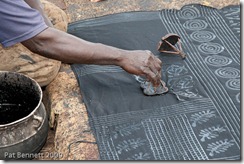
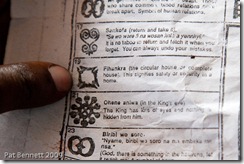
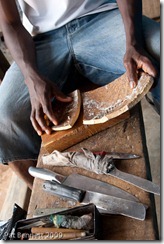
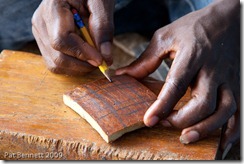
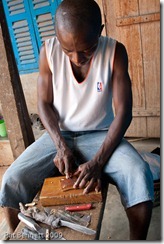
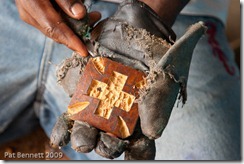
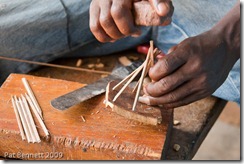
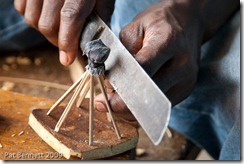
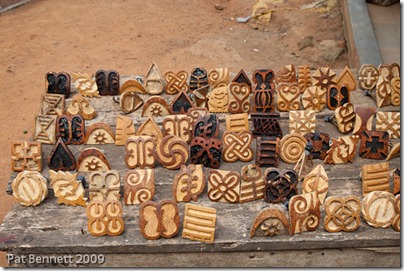
Thanks for sharing such practical (!) information and good photos. I’ve been vaguely aware that gourd shard stamps were used to print fabric in Africa, but since printing blocks are traditionally perfectly flat, it was confusing that all the Adinkra stamps I saw used the harder, smooth outside of the gourd to apply the ink, and couldn’t have b been perfectly flat, because sanding the outer shell would reveal the pulpier, porous interior.
I had to presume that if the gourds were large enough, the shell fragments might not be so convex that they wouldn’t print OK if the padding under the fabric yielded enough.
Your images cover enough angles and zoom in tight enough to make it clear what the deal is, for which I’m extremely grateful. I can hardly wait to get back to the compound to salvage some of the thicker shards from larger gourds (that are rarer and more expensive out here, and painful to discard if the gourd is damaged beyond any other special use).
Thanks for sharing and for doing it so well.
Regards, Kemper C. Stone Vallejo, California
Thank you for this!… Just wanted to let you know, Adinkra is not only used for mourning ceremonies. Adinkra is also used celebratory and forms an aesthetic backdrop to many things in society including; furniture, upholstery, art and so on…
peace
Thank you, Samuel, and peace to you!
Are you a relative of Paul Nyamaah?
Thanks so much. I teach art in the US and every year try to explain this process to my 2nd graders before they make their adinkra symbols and your photos will really make it easier for them to understand.
Hello!
I maybe planning a trip to Ghana. Is it possible to contact him to arrange lessons?
Hi – I have no means of contacting Paul. I would suggest that you go to the village of Ntonso where he lives, and talk to the textile workers. I do not think it would be very difficult to find him, and I am sure he would be delighted to give lessons in his craft.